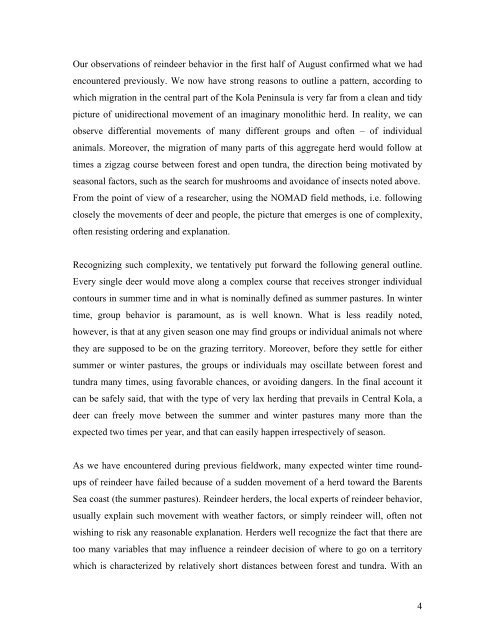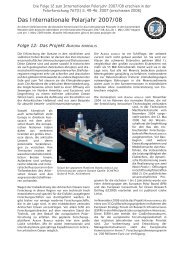You also want an ePaper? Increase the reach of your titles
YUMPU automatically turns print PDFs into web optimized ePapers that Google loves.
Our observations of reindeer behavior in the first half of August confirmed what we had<br />
encountered previously. We now have strong reasons to outline a pattern, according to<br />
which migration in the central part of the Kola Peninsula is very far from a clean and tidy<br />
picture of unidirectional movement of an imaginary monolithic herd. In reality, we can<br />
observe differential movements of many different groups and often – of individual<br />
animals. Moreover, the migration of many parts of this aggregate herd would follow at<br />
times a zigzag course between forest and open tundra, the direction being motivated by<br />
seasonal factors, such as the search for mushrooms and avoidance of insects noted above.<br />
From the point of view of a researcher, using the <strong>NOMAD</strong> field methods, i.e. following<br />
closely the movements of deer and people, the picture that emerges is one of complexity,<br />
often resisting ordering and explanation.<br />
Recognizing such complexity, we tentatively put forward the following general outline.<br />
Every single deer would move along a complex course that receives stronger individual<br />
contours in summer time and in what is nominally defined as summer pastures. In winter<br />
time, group behavior is paramount, as is well known. What is less readily noted,<br />
however, is that at any given season one may find groups or individual animals not where<br />
they are supposed to be on the grazing territory. Moreover, before they settle for either<br />
summer or winter pastures, the groups or individuals may oscillate between forest and<br />
tundra many times, using favorable chances, or avoiding dangers. In the final account it<br />
can be safely said, that with the type of very lax herding that prevails in Central Kola, a<br />
deer can freely move between the summer and winter pastures many more than the<br />
expected two times per year, and that can easily happen irrespectively of season.<br />
As we have encountered during previous fieldwork, many expected winter time roundups<br />
of reindeer have failed because of a sudden movement of a herd toward the Barents<br />
Sea coast (the summer pastures). Reindeer herders, the local experts of reindeer behavior,<br />
usually explain such movement with weather factors, or simply reindeer will, often not<br />
wishing to risk any reasonable explanation. Herders well recognize the fact that there are<br />
too many variables that may influence a reindeer decision of where to go on a territory<br />
which is characterized by relatively short distances between forest and tundra. With an<br />
4




